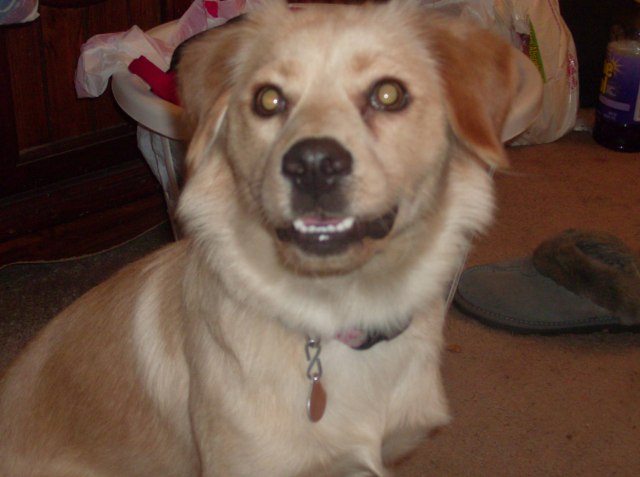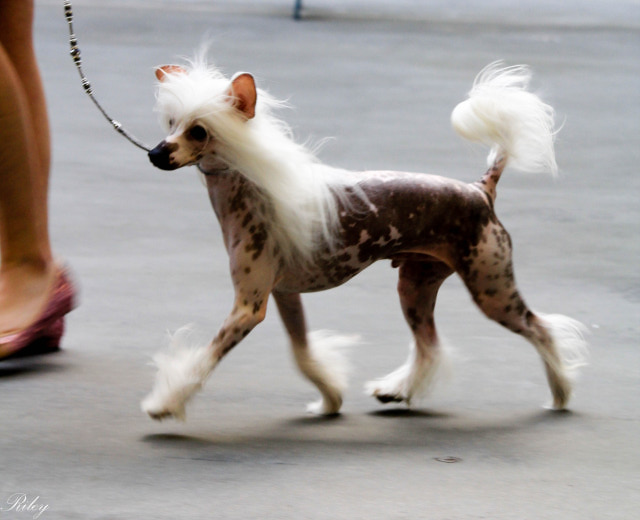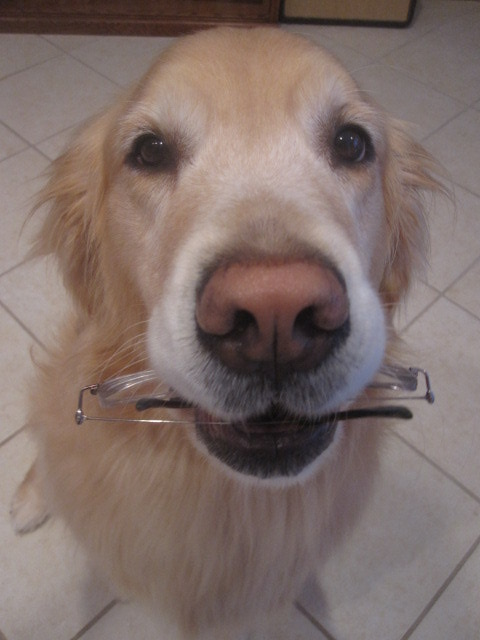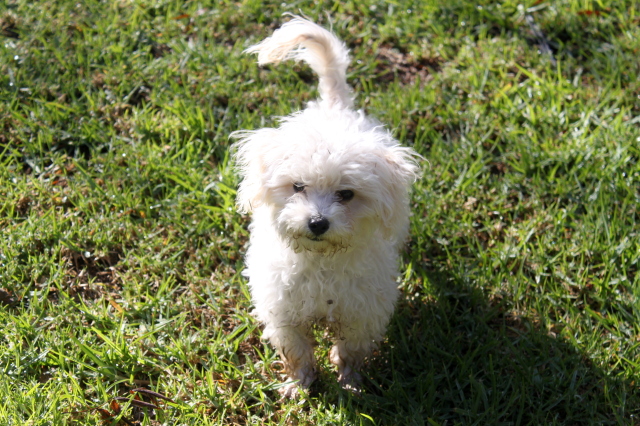QuestionDear Kathleen,
About 4 months ago we adopted a 15-month-old terrier/cattle dog mix. She was written-up as never having been housetrained, which we were a bit leary about. However, after seeing her, we fell in love and had to bring her home to be a friend to our chi-terrier male. She's such a loving, willing-to-please sweetie (except for any strangers who may come around but that's a different issue.) Even housetraining has gone very well considering she spent all her life in someone's backyard without being trained. She's a very fast learner and has taken to following directions wonderfully. At first we kept her crated at night, and she never had a mess in it. We do keep her downstairs during the day, which is a large area with a gate, because she has a tendency to pee when alone, and sometimes poop. We have a doggie door which she was scared to death of for the longest time, but she uses it now, and has learned not to pee downstairs. I've taken care of most of the upstairs pee problem by keeping both dogs on a rigid time schedule re: feeding and drinking no later than 6pm, along with walking before bedtime. But still, if there's a blanket on the floor like when my girls have sleepovers, she sometimes does pee on the blankets. She's learned to not pee on her own sleeping blankets and bed, and she now sleeps on our bed at night and never pees on it, so she's very capable of learning. When we catch her in the act, we give a quick loud "Ack!" so she knows she did wrong, then take her downstairs to go outside. We clean with special enzyme cleaners. She does have a problem with going outside to do her thing at night - she seems afraid unless I'm out with her. I guess my question is, since I walk her before bedtime and monitor her as much as possible, is there something else I can try to help her learn not to pee inside the house? I'd really love to get to the point where she could roam around on her own anywhere like our other dog can. Thank so much!
AnswerIt sounds like you are on the right track. Make sure you have no health concerns and then keep working on her just like she was a youngster. This training can take at least 6-weeks if they are slow on the uptake.
Good Luck!
From my web site:
http://www.outlawchinooks.com/dog_Potty_Training.html House Train
http://www.outlawchinooks.com/dog_crate_training.html Crate Train
http://rileytrainingcenter.blogspot.com
Dog - Potty Training Basics
Going to the bathroom in the house is one of the biggest issues for new puppy owners. You can easily win the battle if you are consistent, patient, use supervision, utilize confinement and reward your pup with scrumptious treats. Remember, you are teaching your puppy where to relieve him or herself rather than where not to relieve him or herself.
One of your first steps is to choose a place that you want your pup to eliminate. Once you have chosen the spot, always take your pup on leash to the spot and stand there for three to five minutes. If you don't have success, take pup back inside and place them in their crate. When you are home, make this trip every hour or two and praise success with voice and treats to expedite the learning process. You pup will quickly learn that elimination bring tasty rewards.
Use a Crate. Most dogs love their "den" as long as it is the right size. If it is too big, part of it will become a bathroom. If it is too small, it is uncomfortable. Your pup should have enough room to stand up, turn around and lay down. When pup is in the crate, provide a food stuffed chew toy like a Kong so pup has something to occupy the confinement time. The crate should help you predict when the pup needs to "go" so you can teach pup where and why it needs to eliminate outdoors.
Outside Time: Puppies need to relieve themselves frequently. Ideally, your pup should go outside every two hours.
Same Time, Same Place: Take pup out on a six-foot leash and stand in the place you want pup to "go." Praise pup for "going" in the right location.
Boo Boo? Show pup his mistake and let him know he was wrong with a firm "No!" Take pup outside and show him how you want it done. (Not literally!)
Don't rub pup's nose in "it" unless you want him to eat "it."
Don't smack him with a rolled up newspaper unless you want him to eat it. If you want to hit something with a newspaper, roll it up and hit yourself for not paying more attention to pup's needs.
Feed to Succeed: A high quality, nutritional, highly digestible diet keeps odors, waste and trips outside to a minimum.
Take pup out:
After eating
After napping
After a play session
First thing in the morning
Last thing at night
When his eyes are crossed
The biggest key to house training success is consistency. The more consistent you are with pup, the quicker pup will give you the desired response. When pup relieves himself outside, pup earns more free time inside your home. One quick method is alternating freedom and confinement.
On a basic level the following guidelines will help you train your puppy:
Follow the house-training schedule strictly. If pup has an accident you have allowed too much freedom.
While standing in one spot with pup on a leash, allow two minutes for relieving himself. Reward immediately (within one second) with a treat or praise after the desired behavior.
Holding "it" all night is the first stage to successful housebreaking.
If your puppy whines and cries at night, please try to ignore the commotion and go back to sleep. (This applies unless pup is hurting itself.) If you get up even to reprimand pup for making noise, you have just shown your pup that you will get up at night. Occasionally dogs must relieve themselves at night, and ignoring will lead to a big mess in the morning. You can respond to the pup's warning by allowing pup out for only two minutes.
For an easy routine to assist in quickly training your pup to "go outside" and avoid most accidents, follow this simple schedule:
In the morning, carry your pup outside and place it on the ground (attached to your leash) that you have designated as the bathroom. Give your command to "go to the bathroom" or "potty" or "tinkle" or some other suitable phrase. Allow two minutes for a response. Gently repeat the command (in a tone of voice like you use with your coworkers) and as soon as pup responds, reward immediately. Remember to bring your reward treat with you no matter how optimistic or pessimistic you feel.
If pup fails to respond within the allotted time, carefully take it inside and place it back in the crate until you are dressed and ready to try again.
When your pup responds correctly, give lots of praise and of course your scrumptious treat. Giving the treat reinforces the desired behavior.
Now pup is going to the bathroom outside and can earn some freedom in your home. The following table shows a suggested daytime schedule.
Goes to the bathroom outside
1/2 hour free time
1-1/2 hours of confinement
This routine continues until pup learns to "go" on command and earns your trust. At that time you can allow more freedom then go to the next level.
Goes to the bathroom outside
1 hour free time
2 hours confinement
This routine continues until pup is doing well. At that time you can allow more freedom.
Goes to the bathroom outside
2 hours free time
2 hours confinement
This entire process may take up to six weeks. Follow the basics covered here and DON'T become discouraged. They are only pups once and we should enjoy all aspects of new companion's lives.

 Running/Non-Obeying
Question
Star
I have a female Lab mix who has this obse
Running/Non-Obeying
Question
Star
I have a female Lab mix who has this obse
 having problems with toilet training
Question
Oscar
hello
A friend of ours dog, Oscar is a 5
having problems with toilet training
Question
Oscar
hello
A friend of ours dog, Oscar is a 5
 Territory Marking
QuestionHi Kathleen and thank you in advance.
I have a
Territory Marking
QuestionHi Kathleen and thank you in advance.
I have a
 question about beagle puppy
QuestionHello, I have recently acquired a beagle puppy.
question about beagle puppy
QuestionHello, I have recently acquired a beagle puppy.
 Young Moodle Trouble
Question
Moodle, male, 10 - 11
I have a two question.
Young Moodle Trouble
Question
Moodle, male, 10 - 11
I have a two question.